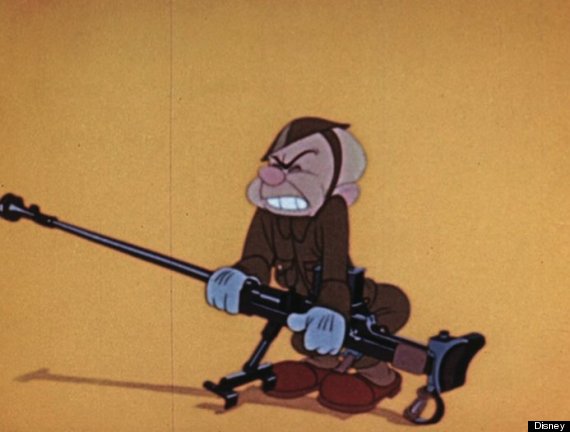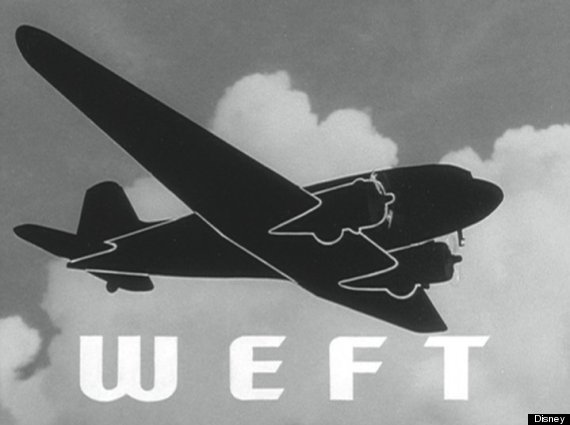
The following is an excerpt from Disney During World War II: How the Walt Disney Studio Contributed to Victory in the War, a book that details the movies, short clips and instructional videos that the company turned out during wartime.
"Stop That Tank!"
Stop That Tank! was a very straightforward training film that used live-action footage of soldiers demonstrating the proper use of the Boys antitank rifle, and animated cutaway views of the gun’s interior to display its inner workings for better overall understanding. But before the instruction begins, the film opens with a cartoon sequence pitting hitler and his tanks against some concealed canadian soldiers armed with the weapon. The german tanks are rickety affairs that clank across the battlefields like toys, and when the hidden gunners open fire at close range, the tanks flee the scene. hitler’s tank gets blown to kingdom come, and he ends up in hades, ranting at the feet of Satan about the unfair advantage provided by the Boys antitank rifle. Ub Iwerks directed and the animators included Freddie Moore and Ward Kimball, who said of the supposedly fearsome weapon, “it looked like a BB gun to me.” Indeed, it had limited tactical worth on the battlefield at the time, but Disney’s job was to explain the gun’s workings and proper use, and to extol its virtues, regardless of its manifest obsolescence. The resulting film was exactly what the canadian government had bargained for, and it remained a standard teaching tool until the Boys gun was replaced by the Piat (Projector, infantry, anti-tank) in 1943.
WEFT Series
The first series of training films produced was intended to teach pilots, air gunners, antiaircraft units, and ground observers how to quickly distinguish enemy planes from allied aircraft. It was called WEFT, a mnemonic abbreviation of “Wings, engine, Fuselage, and tail.” As the name suggests, the WEFT system was a multistep approach that separately analyzed the differences between the four basic component parts of each aircraft. WEFT quickly fell out of favor with the Army and Navy, but not before it had famously acquired the derisive nickname “Wrong every Fucking time.” However, this may have had less to do with the actual deficiencies in the WEFT system than with the robustly cynical sense of humor rampant among World War II servicemen, who gave all military acronyms the same treatment and could hardly be expected to resist so perfect an opportunity for sarcasm as the felicitous arrangement of letters in "WEFT" provided.
"Food Will Win The War"

Claude Wickard, the secretary of agriculture, wanted Disney to do a short about the outsized but unsung role of the american farmer in helping to win the war. the flow of lend-lease food to allied countries was as vital to their survival as were the shiploads of airplanes, tanks, fuel, and munitions.
During the war, the Farm Belt of the united States sustained millions around the world, particularly in england, china, and the Soviet union; through lend-lease, america had become not only the “arsenal of Democracy” but also its larder. But the significance of this mammoth undertaking was not widely appreciated at the time. The Department of agriculture, operating in conjunction with the office of the coordinator of information under William J. Donovan, sought to put a spotlight on the American farmer at home while rallying allied spirits abroad and weakening the morale of enemy nations that could only dream of such a wealth of resources and production capabilities.
Excerpt from DISNEY DURING WORLD WAR II: How the Walt Disney Studio Contributed to Victory in the War by John Baxter ©2014. Reprinted by permission of Disney Editions/Disney Publishing Worldwide.